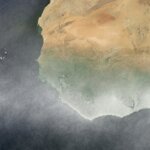Science category landing
Earth Sciences

Growing inside the caves of the tropical Pacific island of Borneo are some of the keys to understanding how the Earth's climate suddenly changed - several times - over the last 25,000 years. By analyzing stalagmites, the pilar-like rock formations that stem from the ground in caves, they were able to produce a high-resolution and continuous record of the climate over this equatorial rainforest.
"These stalagmites are, in essence, tropical ice cores forming over thousands of years," said Partin. "Each layer of the rock contains important chemical traces that help us determine what was going on…

Analyses conducted by researchers from Université Laval’s Center for Northern Studies reveal that aquatic life in Ward Hunt Lake, the continent’s northernmost lake, is affected by climate change.
Ward Hunt Lake is a body of water located on a small island north of Ellesmere Island in the Canadian Arctic, has undergone major transformations within the last two centuries. The speed and range of these transformations—unprecedented in the lake’s last 8,000 years—suggest that climate change related to human activity could be at the source of this phenomenon.
The researchers’ conclusions are…

A new NASA-supported study reports that 2007 melting in high-altitude areas was greater than ever - 150 percent more than average.
Marco Tedesco, a research scientist at the Joint Center for Earth Systems Technology, used satellite data to compare average snow melting from 1988-2006 with what has taken place this summer. He found that in high altitude areas over 1.2 miles above sea level, the melting index -- an indicator of where melting is occurring and for how long - was significantly higher than average. Melting over those areas occurred 25-30 days longer this year than the observed…

Researchers at the University of Bristol say their analysis of sediments from a British bog suggest that methane emissions increased around 55 million years ago due to intense global warming - not the other way around, as some have said.
Dr Richard Pancost and colleagues show that carbon isotope values of hopanoids – compounds made by bacteria – suddenly decrease in a manner that can only be explained by switching to a diet of methane. This suggests that methane emissions must have increased at that time.
Their data point is an important one but shouldn't be overstated, he said. “Although…

Peat and vegetation in northern areas may help protect permafrost from the effects of climate change, according to a recent study by McMaster researchers published in Geophysical Research Letters.
Found in arctic regions, permafrost is frozen soil that remains at or below 0 C for at least two consecutive years. Permafrost covers more than 30 per cent of the Earth's surface and about 42 per cent (four million sq. km) of Canada's land area.
"There is no doubt that northern regions are warming and permafrost is melting as shown by numerous observations and modeling studies," said Dr. Altaf…

The area covered by sea ice in the Arctic has shrunk to its lowest level this week since satellite measurements began nearly 30 years ago, opening up the Northwest Passage – a long-sought short cut between Europe and Asia that has been historically impassable.
In the mosaic image above, created from nearly 200 images acquired in early September 2007 by the Advanced Synthetic Aperture Radar (ASAR) instrument aboard ESA’s Envisat satellite, the dark gray colour represents the ice-free areas while green represents areas with sea ice.
Leif Toudal Pedersen from the Danish National Space Centre…

Large continental ice sheets did not exist in both hemispheres around 41 million years ago during the warmer-than modern conditions of the time.
This is the finding of scientists from the University of Southampton's School of Ocean and Earth Science at the National Oceanography Centre, Southampton (NOCS), reported in Nature.
The Eocene epoch (55 to 34 million years ago) was the last interval of sustained global warmth in Earth's history, a likely consequence of atmospheric carbon dioxide levels much higher than today. It has been known for some time that, at the end of the Eocene, ice sheets…

A new interpretation of data from NASA’s Viking landers indicates that 0.1% of the Martian soil tested could have a biological origin.
Dr Joop Houtkooper of the University of Giessen, Germany, believes that the subfreezing, arid Martian surface could be home to organisms whose cells are filled with a mixture of hydrogen peroxide and water. Dr Houtkooper described how he has used data from the Gas Exchange (GEx) experiment, carried by NASA’s Viking landers, to estimate the biomass in the Martian soil.
Viking 2 lander image looking back across the craft. Dark boulders are prominent against…

Monsoons, the life-giving, torrential rains of Asia and Africa, have an ancient, unsuspected connection to previous Ice Age climate cycles, according to scientists at the University of California, Santa Barbara, and at Kiel University in Germany.
Analyzing a 120-foot sediment core from the Gulf of Guinea in equatorial West Africa recovered by a German research expedition, UC Santa Barbara postdoctoral scholar Syee Weldeab and paleoclimatologist David Lea have revealed 155,000 years of continuous monsoon history. “It is the longest, most detailed record of West African monsoons that has ever…
When the movie Spider-Man 3 swung into theaters a few weeks ago, it found University physics professor James Kakalios waiting. A diehard fan of superhero comics, he takes a double interest in Spidey foe Sandman, who can transform all or part of his body into living sand.
It doesn't always happen, but in the case of Sandman the writers manage to get much of the science right, Kakalios says. After 10 years researching the physics of sand and other granular materials--not to mention writing the bestselling book "The Physics of Superheroes"--he is delighted to see sand finally getting the billing…